Sailing from Richard's Bay to East London

Take Off
Jörgen Wennberg
Sat 18 Nov 2017 15:40
Some pictures from Zululand Yacht Club.  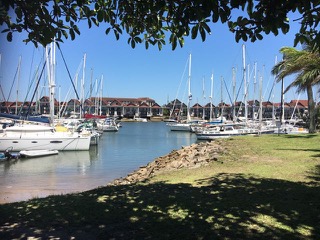 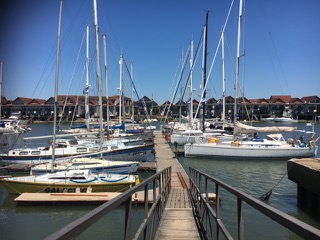  Eileen & Ken (Aurora) with Natasha from the Zululand Yacht Club.  Alex and Inez having fun with Michelle and Daniel as well as some other kids from the club.  On Saturday the 18th of November we left Richard’s Bay going off sailing the Eastern Cape towards Cape Town. The usual good byes among Alex and Inez’s newly found friends. Saying goodbye to Michelle. 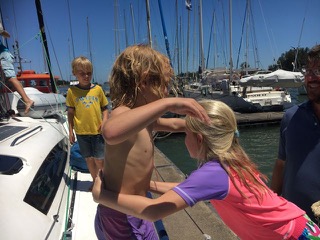   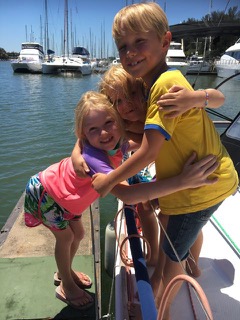 Sailing around the Cape can be a quite tricky passage if one does not follow the weather. What makes it really tricky is the Alguhas current that flows from Mozambique all the way down to the Souther tip of the Cape. The Agulhas Current is the western boundary current of the southwest Indian Ocean. It flows down the east coast of Africa from 27°S to 40°S. It is narrow, swift and strong. It is suggested that it is the largest western boundary current in the world ocean, with an estimated net transport of 70 Sverdrups (Sv, millions m3/s), as western boundary currents at comparable latitudes transport less.  The courses of the warm Agulhas current (red) along the east coast of South Africa, and the cold Benguela current (blue) along the west coast. The Agulhas Current is formed by the confluence of the warm Mozambique and East Madagascar Currents, which meet south-west of Madagascar (not shown in the diagram). The cold Benguela Current originates from upwelling of water from the cold depths of the Atlantic Ocean against the west coast of the continent. The two currents do not "meet" anywhere along the south coast of Africa. As we said earlier the current can be as quick as up to 6 knots! Due to this, one only wants to sail this passage with the wind, that means when it blows from the North East. When it blows from the South West, one does definitely not want to sail down the Alguhas current as that weather combination (the current from the North and the wind from the South West) creates standing waves and can be very hazardous or even dangerous. As before the 1960' there were no coast guard along the Cape, although there were always some boats that capsized every year. However a particular incident occurred in the 1960’s where several fishing boats were lost. The fishermen had had a quite bad fishing year and they needed to come out further to catch their fish and make a living. However they were caught in this bad weather condition and only one boat among several came back safely. After this the National Sea Rescue Institute (NSRI )was created and since then it is operated only thanks to volunteers. In order to be able for them to know who is out there, we are obliged to check out and check in at every port we are stopping. This is so that the NSRI knows which vessels are out there rounding the Cape. A great service ! The National Sea Rescue Institute (NSRI) is a voluntary non-profit organisation in South Africa tasked with saving lives through drowning prevention as well as capsized boats. It consists of coastal stations and inland stations on dam. There are over 1000 volunteers equipped with sponsored rescue craft and rescue vehicles. This is why we had to leave Richard’s Bay only 5 days after arriving there. The weather showed a favourable “weather window”, which means that the winds were going to blow in our favour starting from Saturday 18th of November. As we did not know when the next weather window would occur and that we wished to arrive in Cape Town by the beginning of December, we needed to leave so early. So there was no choice than to go. We left together with 10 boats from the World ARC: Sandvita, Lexington, Hanna, Tulla Mhor, Skyelark, Owl, Arabela, Ashia and Toujours Belle. Coming out of Richard’s Bay, the sea was very very rolly. Plenty of big cargo ships were anchored just outside and even these heavy boats were rolling back and forth like small plastic boat toys. As the wind was blowing pretty hard, we started by taking a reef in the main sail. We thought that the Alguha’s current would give us more knots, but we should be happy with at least 2 knots. However the wind dropped totally and we had to motor during the night. 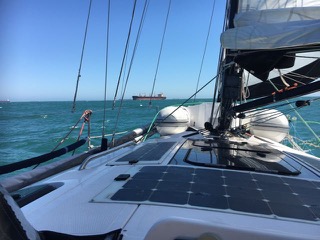   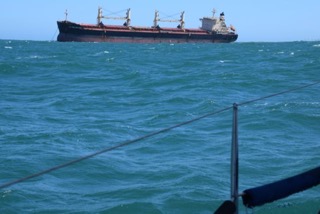 We had a lovely first day sailing in beautiful weather. For this leg from Richard’s Bay to Cape Town, we had the honour to have Victor Taburiaux with us, who is yellow shirt from the World Cruising Club,   We passed by some beautiful landscape as we followed the coast from the Eastern Cape.   The day after we continued by motor hoping to catch more of the Alguha’s current, however still only 2 knots extra. Victor being French, we took the chance to get some help from him for schooling. Louise teached Alex and Victor teached Inez! 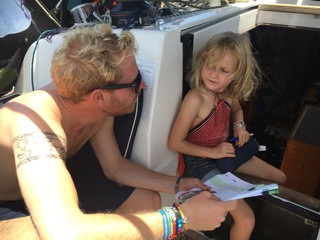 By the end of the day, the wind is blowing more so we are now finally sailing. Sundowner in lovely weather! 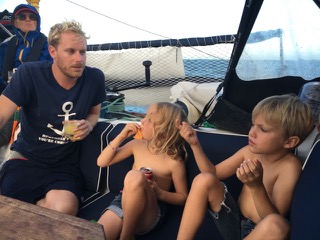     This night when Victor was on watch at 5h00, he woke us up as the wind was blowing up to 40 knots and we needed to take the 2nd reef. Early that morning we entered the harbour of East London.   We had to make this short leg from Richard’s Bay to East London, 330 NM, as the weather forecast predicted South Westerly winds from tomorrow and we do not want to be out there. We docked at the Buffalo River Yacht Club together with Sandvita. 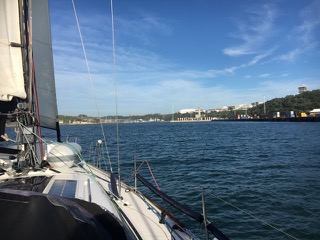  |